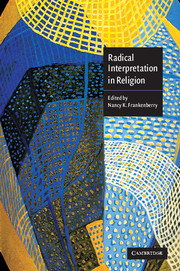Book contents
9 - Religion as a “mobile army of metaphors”
Published online by Cambridge University Press: 13 November 2009
Summary
What then is truth? A mobile army of metaphors, metonyms, and anthropomorphisms – in short, a sum of human relations, which have been enhanced, transposed, and embellished poetically and rhetorically, and which after long use seem firm, canonical, and obligatory to a people.
NietzscheSince Nietzsche, the mobile army conscripted for duty under the banner of “religious truth” has been thought to be largely “symbolic.” As linguistic phenomena, metaphors, metonyms, and anthropomorphisms make their appearances in sentences, whose meaning is now widely regarded as “symbolic meaning.” But, whereas Nietzsche's description of truth is redolent with denunciation and nostalgia (“metaphors which are worn out and without sensuous power; coins which have lost their pictures and now matter only as metal, no longer as coins”), the vitality of notions of “symbolic truth” and “symbolic meaning” remains undisturbed among most students of religion today.
Various reasons have been given for the inescapability of symbolic language in religion, but few writers have distilled these into methodological principles for the comparative scholar of religion as unequivocally as Mircea Eliade. His recommendations boil down to the following six assertions: (1) Religious symbols reveal a “modality of the real” that is not evident on the level of immediate experience. (2) Religious symbols point to something “real,” equivalent to “the sacred,” and imply an ontology. (3) Religious symbols are multivalent, expressive of a number of simultaneous meanings. (4) Religious symbols disclose a certain unity of the world, and provide a “destiny” and “integrating function” for human agents.
- Type
- Chapter
- Information
- Radical Interpretation in Religion , pp. 171 - 187Publisher: Cambridge University PressPrint publication year: 2002
- 13
- Cited by



